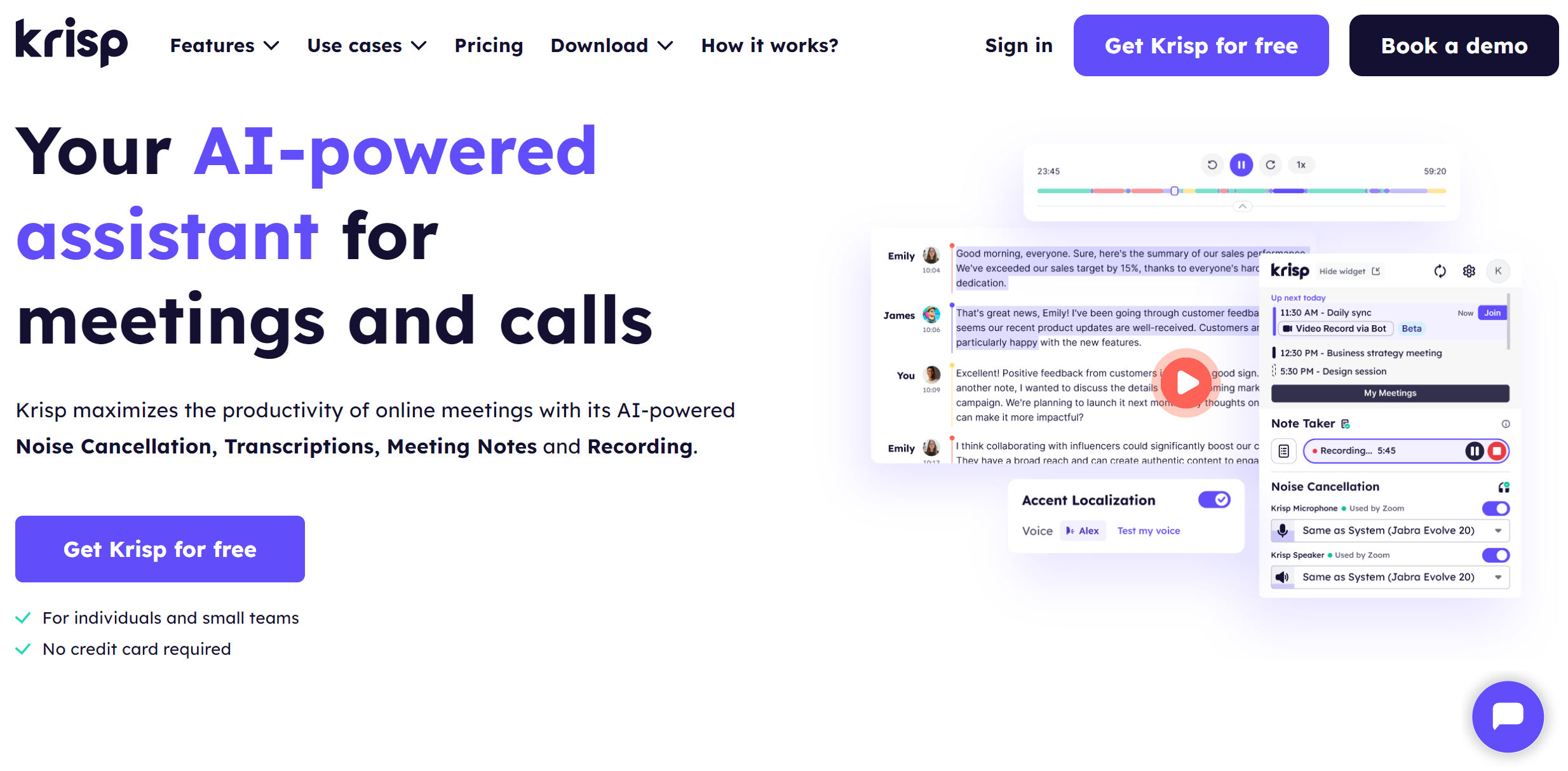Making decisions is a fundamental part of life, whether choosing what to eat or making strategic business decisions. However, the process becomes more complex when it comes to group decision-making. This is where Collaborative Decision Making (CDM) comes in.
CDM is a structured approach that allows team members to contribute their insights, fostering well-rounded and comprehensive decisions.
In this guide, we’ll explore the CDM definition, its importance, processes, models, benefits, and challenges. Also, we’ll see how the Krisp AI Meeting Assistant can make collaborative decision making more effective.
What Is Collaborative Decision Making (CDM)?

Let’s start with simple decision making. It’s a process where a group works together to make decisions, with shared responsibility among all participants. Specifically, each member contributes their expertise and perspectives.
What’s the group or collaborative decision making (CDM) meaning? This type of joint decision making leverages every individual’s perspective to reach more comprehensive and balanced outcomes. This can’t be said about decisions one person or a small leadership team makes.
So, group decision making involves all members collectively contributing to the decision. In this case, each member has an equal voice and influence over the outcome. Compared, in hierarchical decision making, one person or virtual team leaders make the final call.
You may ask, “What is cooperative decision making as compared?” This approach emphasizes working together, but the authority might rest with a leader or select individuals.
Interestingly, a Harvard Business Review article says it’s a myth that CEOs are the ultimate decision-makers: they’re just shaping rather than making decisions.
Psychology Behind Group Decision Making
What’s the psychology behind such collective decision making? Overall, it’s influenced by biases and powered by emotions, memories, and reasoning. Moreover, mental shortcuts like lack of information and social proof guide quick choices.
However, effective and comprehensive decision making requires weighing benefits and costs. So, effective CMD should avoid incomplete information, tight deadlines, and limited resources. Overall, decision making is a data-oriented learning process that improves outcomes.
Examples of Collaborative Decision Making
According to McKinsey research, executives spend about 40% of their time making decisions. Here are a few more examples of collaborative decision making across different fields and contexts:
1. Product Development in Tech Companies
Tech companies often use team-based decision making when developing new products. This approach helps them create functional products that meet the market demand and user expectations.
For example, when developing a new app, a software company might involve:
- Engineers: To provide input on technical feasibility,
- Designers: To ensure the app appeals to the target audience,
- Customer Service Teams: To anticipate user feedback or pain points.
2. Healthcare Teams Making Patient Care Decisions
In hospitals, multidisciplinary teams often gather to decide on the best course of treatment for a patient. In this case, collaborative decision making ensures a holistic approach to meet the patient’s medical, emotional, and social needs.
For instance, when deciding how to treat a patient with multiple chronic conditions:
- Team: Might weigh the benefits and risks of different treatments.
- Final Plan: This could involve multiple interventions, such as physical therapy and medication management, to give the patient the best possible outcome.
3. Educational Curriculum Design
When developing or revising curriculums, schools and universities often involve multiple stakeholders, including administrators, teachers, students, and parents. In this case, CDM ensures that the curriculum reflects the community’s needs and prepares students for the future.
For example, when introducing new technology-focused courses:
- Teachers: Might provide insight into the educational benefits.
- Students: Can share their interest levels.
- Parents: Can contribute thoughts in the long term.
Why Is It Important to Use Collaborative Decision Making?

When individuals feel they’ve contributed to the outcome of participative decision-making, they’re more likely to support its implementation. And such contribution increases the likelihood of success.
Here is why collaborative or group decision making matters:
- Better Problem-solving: Groups can generate more ideas and potential solutions than individuals.
- Increased Engagement: Team members are more invested in outcomes when involved in the decision-making process.
- Encouraged Diversity: Promotes diversity of thought and shared ownership of outcomes.
- Minimized Bias: Having multiple perspectives can reduce the influence of personal biases on decisions.
When Should a Person Use Collaborative Decision Making?
Use this type of consensus decision making when solving complex problems that require multiple perspectives. Or use it when the decision will significantly impact a group.
Here are a few scenarios where CDM is most appropriate:
- When You Need Diverse Expertise: If you’re working on a project that crosses multiple disciplines or departments. CDM ensures that all knowledge areas are included.
- For High-stakes Decisions: If a decision could affect the livelihood or morale of many, such as budget cuts or strategic shifts.
- When Building Consensus: When the buy-in of a team is essential for successful implementation. CDM ensures more significant support.
Benefits of Collaborative Decision Making
A McKinsey survey reveals that inefficient decision making causes typical Fortune 500 company managers to lose 530,000 days of their time yearly. And this number is equivalent to almost $250 million in annual wages.
So, how can co-decision making help?
- Richer Ideas: Working collaboratively brings together people with different backgrounds and areas of expertise, resulting in richer idea generation.
- Higher Buy-in and Greater Success: People feel more committed to the final decision when everyone is involved.
- Increased Innovation: Collaboration among people with diverse perspectives and expertise boosts creativity and increases out-of-the-box solutions.
- Reduced Risk: By pooling knowledge and judging based on data, the team better foresee risks and potential obstacles before they arise.
Disadvantages of Collaborative Decision Making
Shared decision making also has its challenges, especially in a hybrid workplace. So, here are the main disadvantages of CDM:
- Time-consuming: Reaching consensus takes time, and CDM can slow down the process, especially if the group is large.
- Potential for Conflict: Different opinions may lead to tension or disagreements that can delay decisions.
- Groupthink: Managed poorly, collaborative settings can lead to groupthink. This is when individuals conform to the majority opinion to avoid conflict.
- Dilution of Responsibility: Sometimes, having too many people involved can make it unclear who is ultimately responsible for implementing the decision.
Collaborative Decision Making Process
This type of unified decision making is a streamlined, step-by-step process. Here are the steps to follow:
1. Identify the Problem or Decision
Clearly define the problem and decision criteria before discussions begin.
Example: A tech team decides to delay a product launch to improve features or stick to the original timeline.
2. Gather Input and Perspectives
All participants share their ideas and perspectives, ensuring diverse input.
Example: School stakeholders discuss curriculum changes, with teachers, students, and parents contributing insights.
3. Discuss and Evaluate the Options
The group discusses the advantages and disadvantages of each option, weighing the benefits and risks.
Example: Engineers, marketers, and designers weigh the pros of delaying a mobile app launch for feature improvements versus the need to stay competitive.
4. Reach a Consensus or Make a Choice
The group works toward a solution everyone can support, using compromise or voting if necessary.
Example: After extensive discussions, two merging companies agree on a phased employee integration plan.
5. Implement the Decision
Tasks are assigned, deadlines set, and responsibilities made clear to ensure smooth implementation.
Example: A nonprofit assigns teams to execute a new mental health program using newly secured funding.
6. Evaluate the Outcome
The final step is assessing the decision’s effectiveness and identifying lessons for future decisions.
Example: A tech company reviews the success of a product launch, using feedback to improve future development.
Models of Collaborative Decision Making
There are several models and strategies for better decision making. Each offers a structured approach to help groups navigate complex decisions effectively.
Let’s explore some widely used models for CDM:
1. Structured Decision Making (SDM) Methodology
SDM integrates data and stakeholder values to guide complex decisions with transparency and accountability.
Example: A national park service uses SDM to manage wildlife populations by balancing ecological and public interests.
2. Delphi Method
The Delphi method anonymously gathers expert opinions through questionnaires, ensuring informed consensus.
Example: A healthcare organization uses Delphi to craft a new patient care policy by consulting dispersed experts.
3. Consensus Decision Making
This model focuses on reaching a solution everyone supports or can accept, fostering equality and collaboration.
Example: A school board uses this model to create a grading system that satisfies teachers, students, and parents.
4. Responsible, Accountable, Consulted, and Informed (RACI) Matrix
This method clarifies decision-making roles — who is Responsible, Accountable, Consulted, and Informed.
Example: In a corporate project, the RACI matrix defines which teams are responsible for design and who must be informed about decisions.
5. Nominal Group Technique (NGT)
NGT encourages participants to generate and privately rank ideas to prevent groupthink.
Example: A nonprofit collects and ranks ideas from all team members to decide on its fundraising strategy.
6. Collaborative Rational Model
A logical, step-by-step process that relies on data and evidence to guide decisions.
Example: A healthcare research team evaluates medical trial options based on feasibility and expected outcomes.
How Krisp Enhances Collaborative Decision Making

Here is how the Krisp AI Meeting Assistant enhances decision making, facilitating the flow and generation of new ideas:
1. Eliminates Distractions for Better Collaborative Decision Making
Krisp’s unmatched AI Noise Cancelation feature eliminates background noises, voices, and echoes during virtual decision making processes. You can fully concentrate on brainstorming and idea generation.
So, everyone gets focused on the brainstorming and discussion, away from distractions like traffic noise and barking dogs. Such clear and stressless communication results in better decision making.
Users note that the Krisp AI Meeting Assistant’s noise suppression algorithm seems ten times more powerful than its competitors.
2. Gather Information for Wiser Collaborative Decision Making
One of the most critical steps in making a better decision is asking yourself, “Do I have enough information to make it?”
The Krisp AI Meeting Assistant provides a distraction-free environment where you can gather the necessary information in detail. Also, you can weigh the available data to prevent impulsive actions and conduct detailed analyses.
Moreover, Krisp’s AI Meeting Notes and Summaries quickly record critical discussion points and action items without errors. Additionally, Krisp’s AI Meeting Recording records your discussions and brainstorming and provides Screen Recording so you won’t miss anything.
3. Prevents Bias and Impulsive Choices
Bias and impulsive choices or actions ruin the decision-making process. When many people are involved in making a decision, the process gets even more complicated. Thankfully, Krisp’s AI Meeting Transcription and Recording features take meeting minutes and record data without bias.
As a result, group members don’t feel pressured to express natural doubts and concerns. You can use these objective summaries and meeting notes to make stronger, wiser, and more rational decisions.
Krisp’s AI Meeting Transcription provides exceptional 96% accuracy and multilingual transcripts. Because the Krisp AI Meeting Assistant generates summaries and transcripts with stellar speaker recognition. So, there is no need to rewatch the entire recording to get the gist of the discussion.
4. Makes Decision Making Faster
All these features provide faster and effortless decision making. First, Krisp’s AI Meeting Assistant cancels background noises so group members won’t repeat the same idea multiple times.
Then, the Krisp AI Meeting Assistant records the discussions and the screen so you can save all the details for faster analyses. Additionally, Krisp’s AI Meeting Assistant accurately transcribes and summarizes discussions so you will save time on manual note making and note taking.
Finally, the Krisp AI Meeting Assistant doesn’t come with many bells and whistles and can operate bot-free. So participants won’t get annoyed and spend time on distractions.
5. Helps Balance Emotions for Logical Reasoning
Wise decision making is based on balanced emotional insights with logical reasoning. Of course, emotions are fast and helpful for survival, but they often provide false alarms and require reevaluation.
Thankfully, the Krisp AI Meeting Assistant automates Meeting Transcription, Summarization, and Recording to eliminate the impact of emotions.
As a result, such effective integration of emotional and logical perspectives enables participants to make more thoughtful, data-backed, and cautious decisions.
6. Helps Avoid Groupthink
The Krisp AI Meeting Assistant eliminates background noise, ensuring equal participation from remote attendees. Moreover, the Krisp AI Meeting Assistant transcribes and records meetings for later review and sharing among participants for equal access.
Besides, Krisp’s AI Meeting Assistant boosts engagement and accessibility and improves communication quality. Thus, diverse viewpoints and open dialogue are encouraged in such an environment.
Such a transparent environment based on equality prevents dominant voices. Also, it promotes more thoughtful, balanced decision making instead of groupthink.
7. Keeps You Away From Conflict
Krisp’s AI Meeting Assistant promotes clear and uninterrupted communication through noise cancellation. So participants can clearly express their ideas and focus on discussions and brainstorming.
Additionally, the Krisp AI Meeting Assistant’s Recording and Transcription features enable accurate review of discussions. Such smoother and clearer conversations, especially when working remotely, help participants resolve disagreements and clarify points even after discussions.
And this results in a more harmonious collaborative decision making process that is devoid of miscommunication and frustration.
Krisp’s flagship Noise Cancellation technology has been deployed on 200M+ devices. TIME’s top pick for note-taking apps without an in-meeting bot, the Krisp AI Meeting Assistant, is now processing 80B+ minutes of conversations daily.
Feel free to use Krisp’s AI Meeting Assistant on WinOS and MacOS and integrate it with any videoconferencing tool, including Zoom, Goole Meet, and Microsoft Teams.
Final Word
Collaborative decision making helps generate innovative solutions and build team cohesion. It has its challenges, like the potential for conflict and groupthink. However, the benefits, such as shared ownership and diverse input, lead to more thoughtful and well-rounded decisions.
Moreover, leveraging the Krisp AI Meeting Assistant can enhance the CDM process through clear and unbiased communication. As a result, you can enjoy more productive and effective CDM for well-grounded decisions.
Frequently Asked Questions
- Identifying the problem
- Gathering relevant information,
- Generating alternatives
- Evaluating options
- Selecting the best solution
- Implementing the decision while monitoring its progress for adjustments.


